Platinum is a precious metal that is known for its rarity, beauty, and various industrial applications. It is a chemical element with the symbol Pt and atomic number 78 on the periodic table.
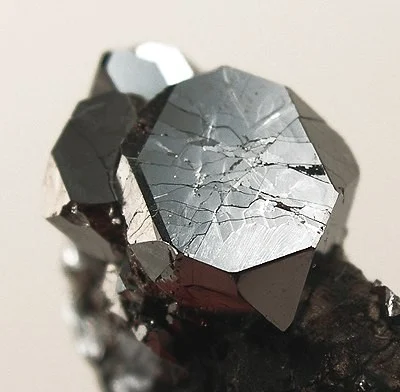
Introduction: Platinum is typically found in nature as a rare mineral, but it is more commonly obtained as a byproduct of other metal mining, particularly from ores containing nickel and copper. It is a dense, malleable, and highly corrosion-resistant metal, making it valuable for various purposes, including jewelry, catalytic converters in automobiles, and industrial applications. Its name “platinum” is derived from the Spanish term “platina,” meaning “little silver,” because early Spanish explorers often encountered platinum alongside silver deposits and initially considered it a nuisance.
Definition as a Mineral: In a geological context, it is considered a mineral when it naturally occurs in the Earth’s crust. It usually forms as small, nugget-like grains or irregular grains within certain types of rocks and ore deposits. Platinum minerals are commonly associated with nickel and copper ores, and the primary mineral source for it is often the mineral sperrylite (PtAs2). Sperrylite is a platinum arsenide mineral that is one of the few naturally occurring minerals containing platinum as its primary component.
Platinum can also occur as an alloy with other elements in nature. For example, native platinum, which consists mainly of platinum (Pt) and minor impurities, is a rare occurrence. It is usually found in alluvial deposits, often associated with other heavy minerals like gold and palladium.
It’s important to note that the vast majority of the world’s platinum production comes from primary sources (ores rich in platinum-group elements), rather than from native platinum. Extracting platinum from its ores and processing it is a complex and energy-intensive industrial process. It is highly prized for its luster, durability, and resistance to tarnish, making it a valuable material in various industries and for decorative purposes.
Cell Data: Space Group: Fm3m. a = 3.9231 Z = 4
Name: From the Spanish platina, diminutive of plata, silver.
Association: Pt–Fe alloys, chalcopyrite, chromite, magnetite
Properties of Platinum
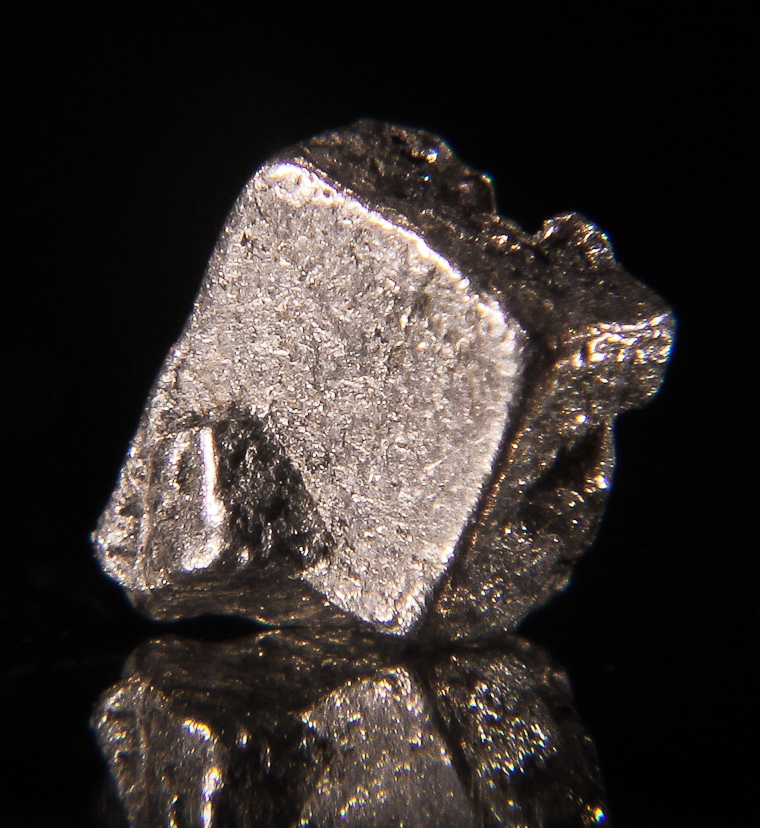
Platinum is a precious metal that is known for its rarity, beauty, and various industrial applications. It is a chemical element with the symbol Pt and atomic number 78 on the periodic table. Here’s an introduction and definition of platinum as a mineral:
Introduction: Platinum is typically found in nature as a rare mineral, but it is more commonly obtained as a byproduct of other metal mining, particularly from ores containing nickel and copper. It is a dense, malleable, and highly corrosion-resistant metal, making it valuable for various purposes, including jewelry, catalytic converters in automobiles, and industrial applications. Its name “platinum” is derived from the Spanish term “platina,” meaning “little silver,” because early Spanish explorers often encountered platinum alongside silver deposits and initially considered it a nuisance.
Definition as a Mineral: In a geological context, platinum is considered a mineral when it naturally occurs in the Earth’s crust. It usually forms as small, nugget-like grains or irregular grains within certain types of rocks and ore deposits. Platinum minerals are commonly associated with nickel and copper ores, and the primary mineral source for platinum is often the mineral sperrylite (PtAs2). Sperrylite is a platinum arsenide mineral that is one of the few naturally occurring minerals containing platinum as its primary component.
Platinum can also occur as an alloy with other elements in nature. For example, native platinum, which consists mainly of platinum (Pt) and minor impurities, is a rare occurrence. It is usually found in alluvial deposits, often associated with other heavy minerals like gold and palladium.
It’s important to note that the vast majority of the world’s platinum production comes from primary sources (ores rich in platinum-group elements), rather than from native platinum. Extracting platinum from its ores and processing it is a complex and energy-intensive industrial process. Platinum is highly prized for its luster, durability, and resistance to tarnish, making it a valuable material in various industries and for decorative purposes.
Physical, Chemical and Optical Properties of Platinum
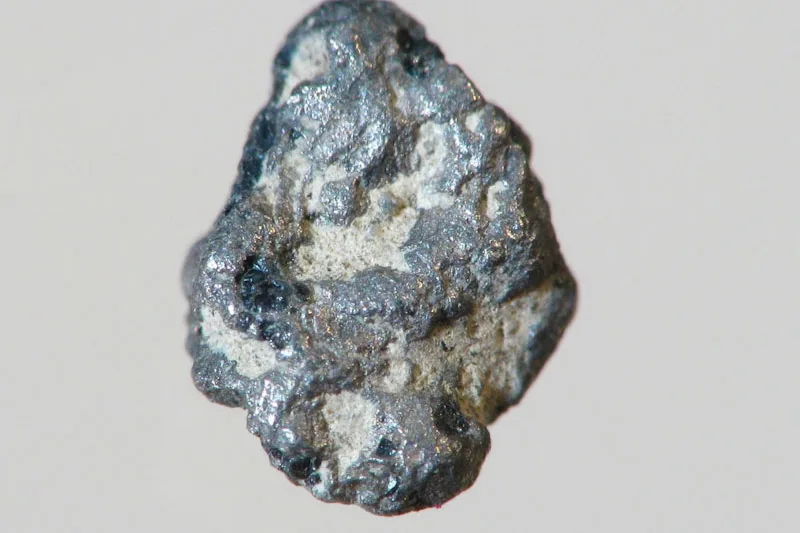
Platinum is a unique and valuable metal with a range of physical, chemical, and optical properties that make it suitable for various industrial, scientific, and decorative applications. Here are some of the key properties of platinum:
Physical Properties:
- Density: Platinum is a very dense metal, with a density of approximately 21.45 grams per cubic centimeter (g/cm³). This high density makes it heavy and gives it a substantial feeling.
- Melting Point: Platinum has a very high melting point of around 1,768 degrees Celsius (3,214 degrees Fahrenheit). This high melting point makes it suitable for high-temperature applications.
- Boiling Point: Platinum’s boiling point is even higher, at around 3,827 degrees Celsius (6,920 degrees Fahrenheit), making it resistant to vaporization at high temperatures.
- Malleability and Ductility: Platinum is a highly malleable and ductile metal, which means it can be easily shaped, rolled, and drawn into various forms, making it ideal for jewelry and industrial processes.
- Hardness: Platinum is a relatively soft metal compared to some other precious metals, but it is still harder than most base metals. Its hardness can be improved by alloying with other elements.
- Color: Platinum has a distinctive silvery-white color, which contributes to its desirability for jewelry and other decorative purposes.
Chemical Properties:
- Chemical Inertness: One of the most notable chemical properties of platinum is its resistance to corrosion and chemical reactions. It is highly inert and does not readily react with oxygen, water, or most common acids, making it an excellent choice for use in corrosive environments.
- Catalytic Properties: Platinum is a highly effective catalyst for various chemical reactions. Its surface can facilitate reactions that are important in industries such as automotive (in catalytic converters) and chemical production.
- Alloying: Platinum can be easily alloyed with other metals, such as iridium, palladium, and rhodium, to enhance its properties and create alloys with specific characteristics.
Optical Properties:
- Luster: Platinum has a brilliant metallic luster, which adds to its visual appeal, making it a sought-after metal for jewelry and other ornamental purposes.
- Reflectivity: Platinum is highly reflective, both in the visible and infrared spectra. This property is essential in applications like laboratory equipment and mirrors.
- Transparency: Platinum is not transparent, as it is a dense metal that does not allow the passage of light. It is often used in the form of thin foils for some optical applications.
These properties make platinum a versatile and valuable material for various applications, ranging from jewelry and decorative items to industrial catalysts, laboratory equipment, and high-temperature engineering. Its exceptional resistance to corrosion and tarnish, coupled with its unique catalytic properties, make it an indispensable element in many technological and scientific fields.
Formation and Occurrence of Platinum

Platinum is a relatively rare and precious metal that is formed through natural geological processes. It is found in various geological settings as part of specific ore deposits. The formation and occurrence of platinum are influenced by its association with other elements, primarily nickel and copper. Here is an overview of how platinum is formed and where it is typically found:
Formation of Platinum:
- Magmatic Processes: The primary source of it is magmatic ore deposits, which originate from the cooling and solidification of molten rock (magma) deep within the Earth’s mantle and crust. These deposits are associated with igneous rocks and are known as “platinum group element (PGE) deposits.” PGEs, including platinum, palladium, and rhodium, are often found together in these deposits.
- Crystallization: During the cooling of magmas, minerals rich in platinum and other PGEs crystallize from the molten material. These minerals may include sulfides like sperrylite (PtAs2), cooperite (PtS), and braggite (Pt, Pd, Ni)S. Platinum is often found in combination with these minerals.
Occurrence of Platinum:
- Layered Intrusions: One of the most significant geological settings for platinum deposits is in layered intrusions, which are large, layered igneous rock formations that often extend deep within the Earth’s crust. These intrusions are typically associated with ultramafic and mafic rock types and are characterized by the presence of platinum-rich sulfide minerals.
- Ophiolite Complexes: Platinum deposits can also be found in ophiolite complexes, which are fragments of oceanic crust and upper mantle rocks that have been thrust onto continental landmasses. These complexes can contain platinum-bearing ore deposits, particularly in association with chromite ores.
- Alluvial Deposits: In some cases, platinum is eroded from primary sources like layered intrusions and transported by rivers and streams. Over time, it can accumulate in alluvial deposits, often alongside other heavy minerals such as gold. This is where native platinum, which is nearly pure platinum metal, is occasionally found.
- Residues from Industrial Processes: Platinum is sometimes a byproduct of various industrial processes, particularly those involving the refining of nickel and copper ores. In such cases, platinum is extracted from the residues of these processes.

It’s important to note that it is relatively rare in the Earth’s crust, and its mining and extraction can be economically challenging due to its low natural abundance. The largest producers of platinum are typically South Africa, Russia, and Zimbabwe, where significant deposits of platinum group elements are found.
The exploration and extraction of platinum are carried out using a combination of geological surveys, drilling, and mining techniques to locate and extract the metal from its primary sources, making it an essential resource for various industrial applications, including catalytic converters in automobiles and the production of high-value jewelry.
Application and Uses Areas
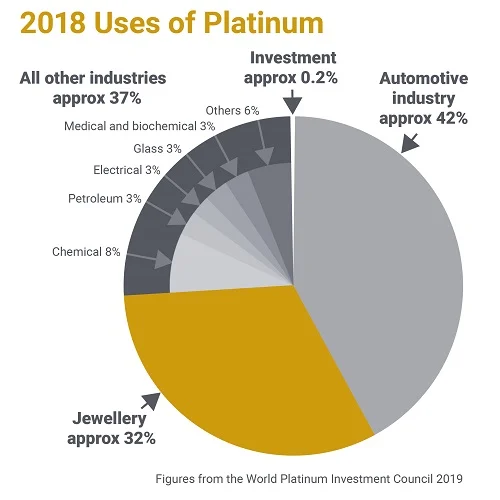
Platinum has a wide range of applications and is used in various industries due to its unique combination of physical and chemical properties. Some of its primary application areas and uses include:
- Automotive Industry:
- Catalytic Converters: It is a key component in catalytic converters, which are used to reduce harmful emissions from vehicles by converting pollutants like carbon monoxide (CO), hydrocarbons (HC), and nitrogen oxides (NOx) into less harmful substances. Palladium and rhodium, also part of the platinum group metals (PGMs), are used in catalytic converters alongside platinum.
- Jewelry and Ornaments:
- Precious Jewelry: Platinum is highly prized in the jewelry industry for its lustrous appearance, durability, and rarity. It is often used to make engagement rings, wedding bands, necklaces, and other fine jewelry.
- Electronics:
- Electrodes: Platinum’s excellent electrical conductivity, resistance to corrosion, and stability make it a valuable material for various electronic components, including electrodes used in devices like sensors, pacemakers, and high-precision measuring instruments.
- Medical and Dental Applications:
- Implants: Platinum is used in medical implants like pacemakers and stents due to its biocompatibility and resistance to corrosion within the human body.
- Dental Restorations: Platinum can be found in dental alloys used for restorations such as crowns, bridges, and dental braces.
- Industrial Processes:
- Chemical Industry: Platinum serves as a catalyst in numerous chemical reactions, including the production of chemicals, pharmaceuticals, and petrochemicals.
- Oil Refining: Platinum is used in the petroleum industry to catalyze various refining processes, such as the removal of impurities from crude oil and the production of high-octane gasoline.
- Glass Manufacturing:
- Glass Fiber Production: It is used in the production of high-quality glass fibers used in fiber optics and telecommunications.
- Aerospace and Space Exploration:
- Rocket Engines: Platinum’s high melting point and resistance to high temperatures make it suitable for use in rocket engines and aerospace components.
- Renewable Energy:
- Fuel Cells: It is used as a catalyst in hydrogen fuel cells, which can be employed for clean and efficient energy generation.
- Solar Cells: It is used in the production of solar cells, where it helps improve the efficiency and longevity of the cells.
- Laboratory and Scientific Equipment:
- Crucibles: Platinum crucibles are used for high-temperature and high-purity applications in laboratories.
- Thermocouples: It is used in thermocouples for precise temperature measurement.
- Currency and Bullion:
- Some countries, such as the Isle of Man and the United Kingdom, have used platinum coins as a form of currency.
- Platinum bullion bars and coins are also traded as a form of investment.
It’s important to note that platinum is a relatively expensive and rare metal, which can influence its application in various industries. Additionally, the high cost of extraction and refining plays a role in determining the availability and usage of platinum in different sectors. Its unique properties, especially its catalytic abilities and resistance to corrosion, make it invaluable in applications where other materials fall short.
Mining Sources and Distribution
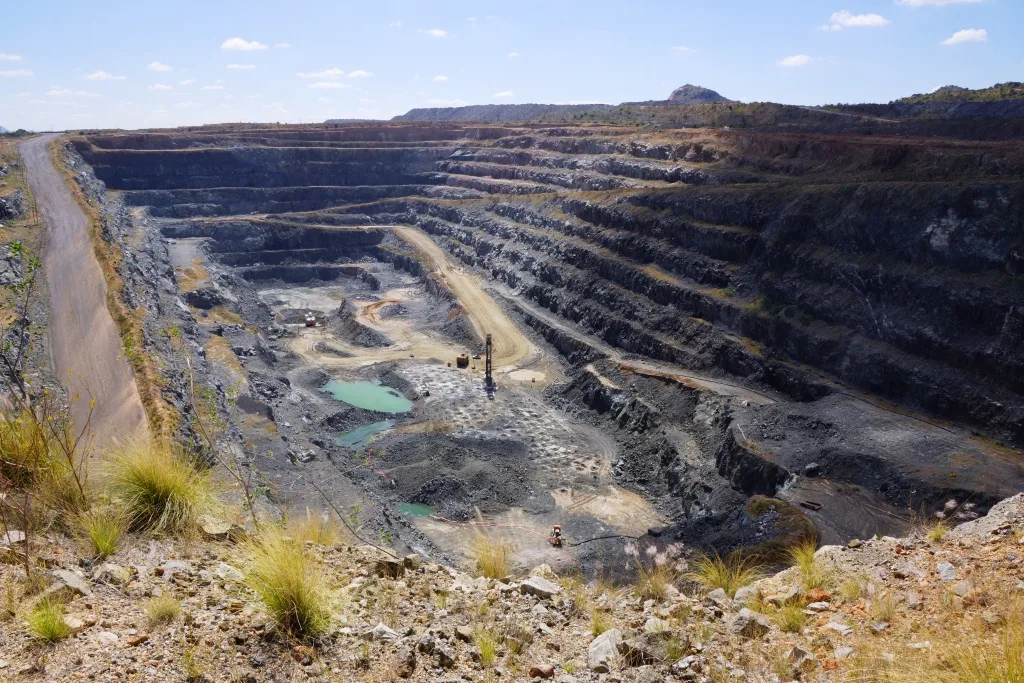
Platinum is primarily mined from specific geological sources and is not evenly distributed around the world. The majority of platinum production comes from a few key regions with significant platinum deposits. Here are some of the main mining sources and the distribution of platinum:
1. South Africa:
- South Africa is the world’s largest producer of platinum, accounting for a substantial portion of the global supply. The Bushveld Complex in South Africa is a vast geological formation that contains numerous platinum group element (PGE) deposits, including platinum, palladium, rhodium, and others. Mines in this region, such as the Rustenburg and Mogalakwena mines, are among the most productive in the world.
2. Russia:
- Russia is the second-largest producer of platinum globally. The majority of Russian platinum production comes from the Norilsk-Talnakh region in Siberia. The deposits here are also part of large PGE-rich intrusions.
3. Zimbabwe:
- Zimbabwe is another significant producer of platinum. Mines like the Great Dyke project have contributed to Zimbabwe’s growing role in global platinum production.
4. Canada:
- Canada is known for its platinum production from the Lac des Iles Mine in Ontario. Canadian platinum mining primarily extracts nickel along with platinum group elements.
5. United States:
- The Stillwater Complex in Montana, United States, is a notable source of platinum and palladium. It is one of the few locations outside of South Africa and Russia with economically viable platinum mining.
6. Other Countries:
- Several other countries also produce platinum to a lesser extent, including Australia, Colombia, and Botswana, among others.
It’s important to note that while it is found in various parts of the world, the largest and most productive deposits are concentrated in just a few regions. Additionally, platinum is often produced as a byproduct of other mining operations, particularly those focused on nickel and copper. The platinum group elements (PGEs), which include platinum, palladium, rhodium, iridium, ruthenium, and osmium, are often found together in these deposits.
The mining and extraction of platinum are capital-intensive processes, and the metal’s high market value reflects the challenges and costs associated with its production. Additionally, the availability of platinum can be influenced by factors such as political stability, economic conditions, and environmental regulations in the countries where it is mined. These factors can impact the global distribution of platinum and its supply to various industries, including the automotive and jewelry sectors.
References
- Bonewitz, R. (2012). Rocks and minerals. 2nd ed. London: DK Publishing.
- Handbookofmineralogy.org. (2019). Handbook of Mineralogy. [online] Available at: http://www.handbookofmineralogy.org [Accessed 4 Mar. 2019].
- Mindat.org. (2019). Platinum: Mineral information, data and localities.. [online] Available at: https://www.mindat.org/ [Accessed. 2019].




































